February 3rd, 2013
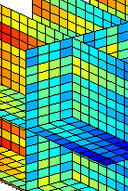 In an earlier post I described enhancing well-being as one of the grand challenges of cognitive design. I received emails and comments asking for more detail. Fortunately, the Society of Personality and Social Psychology just held an annual meeting that highlighted some relevant findings. Researchers reported on several surprising connections between actions and well-being including:
In an earlier post I described enhancing well-being as one of the grand challenges of cognitive design. I received emails and comments asking for more detail. Fortunately, the Society of Personality and Social Psychology just held an annual meeting that highlighted some relevant findings. Researchers reported on several surprising connections between actions and well-being including:
* Getting a good night sleep enhances our ability to feel gratitude and other prosocial emotions which is essential for well-being.
* Spending money on others or even giving money (and time away) enhance our sense of wealth and contributes to a sense of well-being.
* Buying experiences (e.g. going to a concert) rather than something material (e.g. a new shirt) and telling stories about it enhances our sense of well-being.
Designs that maximize the psychological effects of being well-rested, generate a wealth effect from giving, and help us savor experiential purchases are examples of some of the cognitive effects we can consider when designing for well-being. Once we reach a basic level of health, wealth and happiness further enhancing well-being requires some real insight into how minds actually work.

Posted in Examples | No Comments »
January 30th, 2013
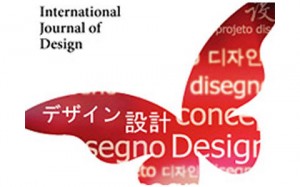 Check out the open access International Journal of Design. It includes many articles of relevance to cognitive designers for example, 25 Positive Emotions in Human-Product Interactions. There is a current call out (due March 1, 2013) for papers on designing for subjective well-being.
Check out the open access International Journal of Design. It includes many articles of relevance to cognitive designers for example, 25 Positive Emotions in Human-Product Interactions. There is a current call out (due March 1, 2013) for papers on designing for subjective well-being.
Like behavior change, designing for well-being is one of the grand challenges of cognitive design. Well-being, often viewed as a combination of health, prosperity and happiness is being defined by the editors as “someone’s enduring life appreciation.” They point out there is growing interest in the topic and that:
“This growing interest can be observed in the lively discussions on topics such as empathic design, value-centred design, socially responsive design, meaningful design, positive design, and happiness-driven design.”
I agree. They are looking for long and short papers that present frameworks and tools for well-being driven design as well as a discussion of the ethical and social implications.

Posted in Events, Related Fields | 2 Comments »
January 27th, 2013
About three years ago in my Cognitive Design class at Northwestern a small group of students focused on applying insights from reversal theory to hard design problems. They used it as a way to model motivational states – one of the four psychology states (motivational, affective, intellectual and volitional) we study in cognitive design.
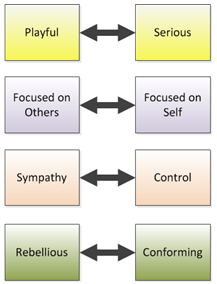 The idea behind reversal theory is that human motivations are complex and often conflicting. We can model motivation in terms of four types of states and how we switch or reverse our positions on each. The four states include how we are:
The idea behind reversal theory is that human motivations are complex and often conflicting. We can model motivation in terms of four types of states and how we switch or reverse our positions on each. The four states include how we are:
1. playful or serious
2. other or self-focused
3. focused on control or sympathy
4. conforming or challenging.
Our motivation in any given context can be explained as a mixture of these four states. Changes in our motivation are caused by reversals in any one of the states. For example when we go from playful to serious or from sympathetic to controlling. They shape the meaning we assign to events and objects which in turn generate emotions such as enjoyment, communal feeling, caring and a sense of freedom.
Michael Apter, a leading researcher in reversal theory goes farther emphasizing the central role of motivation in determining emotion:
“But to the extent to which designers deliberately attempt to induce emotions, they typically overlook the fact that emotions arise only through motivations, each emotion representing a desirable or undesirable way of experiencing a particular motivation. Reversal theory has the potential to provide a framework for design by identifying ways in which ‘things’ (in the most general sense) induce motivational states. “
To bring it to a sharper point, as cognitive designers we can consider features and functions that trigger a reversal in any of the four mental states described above.
For a designer friendly introduction check out the reversal theory training site.

Posted in Events, Psychographics | 16 Comments »
January 23rd, 2013
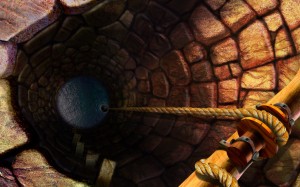 In my leadership class at Northwestern University we spend time learning how to identify the basic assumptions that make up the shared mental model in a given culture. These can run deep, as deep as philosophy. For example, some cultures believe fundamentally in the ability of science to produce objective knowledge while other cultures don’t even know science and believe in oral history as the primary source of knowledge. Or less dramatically, some corporations believe in making decisions based on data and math while others are happy to follow the intuitions of a small group of leaders.
In my leadership class at Northwestern University we spend time learning how to identify the basic assumptions that make up the shared mental model in a given culture. These can run deep, as deep as philosophy. For example, some cultures believe fundamentally in the ability of science to produce objective knowledge while other cultures don’t even know science and believe in oral history as the primary source of knowledge. Or less dramatically, some corporations believe in making decisions based on data and math while others are happy to follow the intuitions of a small group of leaders.
Basic assumptions go unquestioned and usually involve beliefs in what is real, how you acquire knowledge and truth and what constitutes value.
So I am always on the lookout for new insights into the basic assumptions that shape how groups of people perceive the world, think, make decisions and behave. Take for example the excellent article and interview in Strategy + Business on the Dueling Myths of Business. The article identifies five basic assumptions about economics (seeking growth), ecology (seeking health of a larger system), heroics (seeking to win), religion (seeking goodness) and science (seeking truth through reason).
Each of the basic assumption is rooted deeply in human psychology:
“The idea of business, for example, is a very powerful human creation, based on the economic myth: The best thing to do is to grow as large as possible. This myth is closely linked to the parental impulse, which is one of the most powerful impulses that human beings have.”
And they all have limits, for example:
“The ecological myth says that the health of a whole system depends on complex interrelationships. It therefore tries to take everyone’s needs into account, which can lead to immense expense and gridlock.”
Understanding what your group believes around each of the five basic assumptions can help leaders mitigate disputes as well as guide fundamental change. They are also an excellent source of insights for cognitive designers looking to create processes and programs that improve group performance.
Source of image: Deep Well

Posted in Psychographics | No Comments »
January 16th, 2013
 The mighty beverage maker is bringing some of their marketing and branding magic to work on the problem of obesity. Check out their Coming Together video and website. While the video stresses the many things the company has already done to address obesity – created lower calorie versions of nearly all beverages, made calorie count more visible, restricted beverage offerings in schools to water, juice and low calorie choices, and so on – it looks to be just the start of a broader campaign. Check out the get involved and newsletter options in Where do we go from here?
The mighty beverage maker is bringing some of their marketing and branding magic to work on the problem of obesity. Check out their Coming Together video and website. While the video stresses the many things the company has already done to address obesity – created lower calorie versions of nearly all beverages, made calorie count more visible, restricted beverage offerings in schools to water, juice and low calorie choices, and so on – it looks to be just the start of a broader campaign. Check out the get involved and newsletter options in Where do we go from here?
They are already attracting critics that claim the approach is too simplistic or a matter of PR. One thing is for sure, the changes they have made already avoided the consumption of many millions of calories. Let’s hope they are serious about using their brand and influence to address our obesity crisis.
I am interested to hear from readers about specific actions Coca Cola can take that will fight obesity while simultaneously improving their bottom line.

Posted in Behavior Change, Service Innovation | No Comments »
January 12th, 2013
 A belief in a god or gods and the institutions and practices that go along with it are a powerful psychological experience for millions of people daily. The opportunities for cognitive designers to learn from and enhance that experience are numerous. Some examples:
A belief in a god or gods and the institutions and practices that go along with it are a powerful psychological experience for millions of people daily. The opportunities for cognitive designers to learn from and enhance that experience are numerous. Some examples:
So I am always on the look out for scientific studies on the nature of religious beliefs, experiences and artifacts with insights that are useful for cognitive designers.
Take for example, the recent article in Trends in Cognitive Sciences on the Origins of Religious Disbelief. The researchers argue that non-belief flows from cognitive, motivational and cultural learning sources and takes four different forms. An excellent framework for cognitive designers working on programs to convert non-believers. The article also catalogs some 9 mechanisms involved in driving the intensity of religious beliefs that could be used to inform the design of religious artifacts and experiences.
I am interested to hear from readers that are working on applications in religion.
Source of Image: Religious Symbols

Posted in Cognitive Bias, Psychographics, Related Fields | 7 Comments »
January 8th, 2013
 The first round of competition for the M-prize on innovating innovation just closed. There are a 134 entries presenting hacks (disruptive ideas) or stories on how we can make innovation a natural act for organizations. It is a wonderful resource for cognitive designers looking for the latest thinking on improving innovation.
The first round of competition for the M-prize on innovating innovation just closed. There are a 134 entries presenting hacks (disruptive ideas) or stories on how we can make innovation a natural act for organizations. It is a wonderful resource for cognitive designers looking for the latest thinking on improving innovation.
I submitted a hack, Create an Army of Innovators with 125 habit formation cards, that presents the work I am doing with Jason Becker’s mobile app development team. We are creating an online marketplace for decks of knowledge cards designed to create new habits that you can access from an iPhone or iPad.
We are going to launch in iTunes a bit later in the year with 5 decks designed to create the innovation habit and 2 decks for mastering personal change including a deck of Willpower cards. Additional decks are already in the works and we are looking to partner with others interested in creating knowledge cards to address a specific behavior change or skill building challenge.

Posted in Behavior Change, Events | No Comments »
January 4th, 2013
 Historically we have measured general intelligence using a single number – IQ. That’s not a good idea according to research led by the Brain and Mind Institute at Western University in Canada. They put a set of 12 standardized tests that measure reasoning, planning, memory and other aspects of intelligence online and got some 100,000 people to complete them. Researchers ran a few subjects through a fMRI scanner as they completed the test so they could also look at the activity in various brain regions.
Historically we have measured general intelligence using a single number – IQ. That’s not a good idea according to research led by the Brain and Mind Institute at Western University in Canada. They put a set of 12 standardized tests that measure reasoning, planning, memory and other aspects of intelligence online and got some 100,000 people to complete them. Researchers ran a few subjects through a fMRI scanner as they completed the test so they could also look at the activity in various brain regions.
 What they found was that human intelligence emerges from the interaction of three independent cognitive components including working memory, reasoning and a verbal component.
What they found was that human intelligence emerges from the interaction of three independent cognitive components including working memory, reasoning and a verbal component.
They published the results as Fractionating Human Intelligence, in the journal Neuron.
The amount of data generated on IQ is unprecedented and is rich in finding relevant for cognitive designers. For example:
“Intriguingly, people who regularly played computer games did perform significantly better in terms of both reasoning and short-term memory. And smokers performed poorly on the short-term memory and the verbal factors, while people who frequently suffer from anxiety performed badly on the short-term memory factor in particular”.
You can access the tests they used online for free at Cambridge Brain Science. You can also participate in the next round of the study HERE. These test are useful tools for cognitive designers interested in showing their innovations are improving baseline intelligence.
For other practical tools for estimating impact on cognition check out measure how well your brain works and measure your cognitive performance.
I am interested to hear from readers that take these tests or use them in cognitive design work.

Posted in Psychographics | 8 Comments »
December 31st, 2012
Earlier this year I described a design contest sponsored by the BrainArt project that looked especially relevant for cognitive designers. They wanted submissions that use art and design to convey the neuroscience of everyday pleasure. There were many entries and the results can be viewed in a virtual gallery.
I was especially proud that my son, Maxim Clare won a special mention for his piece on:
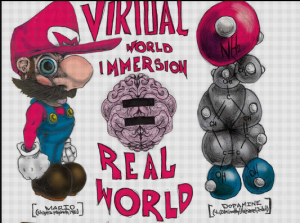 VIRTUAL IMMERSION, REAL REWARD
VIRTUAL IMMERSION, REAL REWARD
“Video games are akin to the mind in that they create worlds. Immersion is when we find ourselves lost in these worlds. To be lost in these worlds is to free of what was once possible. The physiology responds with bursts of neurotransmitters from the reward and attention centers. The process drives us deeper. A cycle is born, we are immersed.”
His graphic illustrates Mario, a well-known video game character morphing into a dopamine molecule. He developed this in part as a response to: An argument against immersion in video games.
Immersion is just one concept developed during the BrainArt contest that is relevant to cognitive designers. I am interested to hear from readers that see others.

Posted in Events | No Comments »
December 27th, 2012
Machines are getting smarter and that good news for cognitive designers. It increases the range of options we have for offloading mental effort from people to machines. Lowering the cognitive load on individuals and groups during work or play is an important trend in technology. Google helps us search the world’s information, eharmony helps us find a mate and our mobile phone helps us navigate. So I am always on the lookout for insights into the limits and trends of artificial intelligence that might be useful for designers.
 Take, IBM’s 5 in 5 for example. They provide a short introduction into how machine perception will develop over the next five years. They look at emerging machine capabilities in all five human senses – vision, hearing, smell, touch and taste – in video and story map form. They offer predictions within the broader view of cognitive systems.
Take, IBM’s 5 in 5 for example. They provide a short introduction into how machine perception will develop over the next five years. They look at emerging machine capabilities in all five human senses – vision, hearing, smell, touch and taste – in video and story map form. They offer predictions within the broader view of cognitive systems.
Bottom line – cognitive designers need to be up to speed on the costs, risks and functional capabilities of current and emerging capabilities in artificial intelligence. How else can we design for how minds (people and machine) really work?
Image Source: Innovations that will change our lives in the next five years.

Posted in Augmented Cognition, Related Fields | No Comments »
 In an earlier post I described enhancing well-being as one of the grand challenges of cognitive design. I received emails and comments asking for more detail. Fortunately, the Society of Personality and Social Psychology just held an annual meeting that highlighted some relevant findings. Researchers reported on several surprising connections between actions and well-being including:
In an earlier post I described enhancing well-being as one of the grand challenges of cognitive design. I received emails and comments asking for more detail. Fortunately, the Society of Personality and Social Psychology just held an annual meeting that highlighted some relevant findings. Researchers reported on several surprising connections between actions and well-being including:








